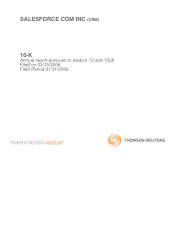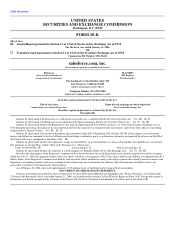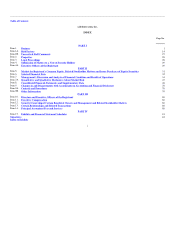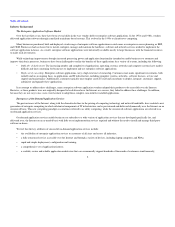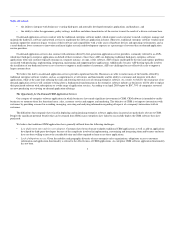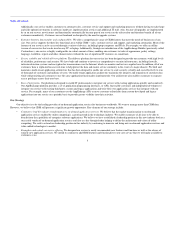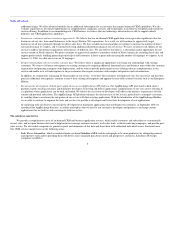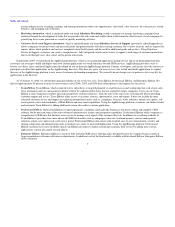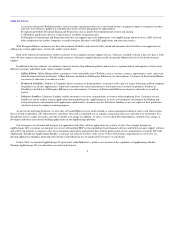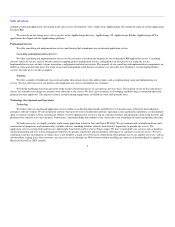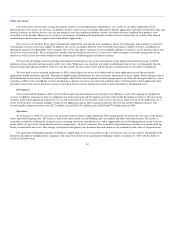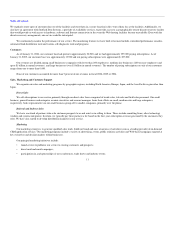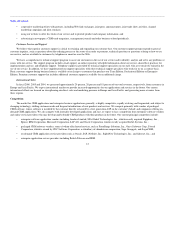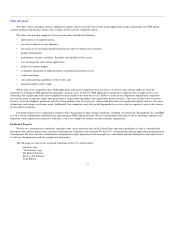Salesforce.com 2005 Annual Report Download - page 6
Download and view the complete annual report
Please find page 6 of the 2005 Salesforce.com annual report below. You can navigate through the pages in the report by either clicking on the pages listed below, or by using the keyword search tool below to find specific information within the annual report.
Table of Contents
• the ability to integrate with businesses' existing third-party and internally developed enterprise applications and databases; and
• the ability to tailor the appearance, policy settings, workflow and other characteristics of the service to meet the needs of a diverse customer base.
On-demand application services contrast with the traditional enterprise software model, which requires each customer to install, configure, manage and
maintain the hardware, software and network services to implement the software application in-house. Moreover, traditional enterprise software vendors must
maintain support for numerous legacy versions of their software and compatibility with a wide array of hardware devices and operating environments, and as
a result dedicate fewer resources to innovation and incur higher research and development expenses as a percentage of revenue than on-demand application
service providers.
On-demand application services also contrast with solutions offered by first-generation application service providers, commonly referred to as ASPs,
which host third-party enterprise applications on behalf of their customers. Since these ASPs are deploying traditional third-party enterprise software
applications with each customer typically running on a separate instance, or copy, of the software, ASPs remain challenged by the time and expense problems
associated with purchasing, implementing, integrating, maintaining and supporting these applications. Additionally, because ASP hosting typically involves
the installation of one dedicated server or set of servers to support a small number of customers, ASPs are challenged to cost-effectively scale to support a
larger customer base.
We believe the shift to on-demand application services provides significant benefits. Businesses are able to realize many of the benefits offered by
traditional enterprise software vendors, such as a comprehensive set of features and functionality and the ability to customize and integrate with other
applications, while at the same time reducing the risks and lowering the total costs of owning enterprise software. As a result, we believe the emergence of on-
demand application services will continue to bring about a fundamental transformation in the enterprise software industry as businesses will be able to replace
their purchased software with subscriptions to a wide range of application services. According to an April 2005 report by IDC, 79% of companies surveyed
are now purchasing or reviewing on-demand application offerings.
The Opportunity for On-Demand CRM Application Services
One category of enterprise software applications in which businesses have made significant investments is CRM. CRM software is intended to enable
businesses to automate three key functional areas: sales, customer service and support, and marketing. The objective of CRM is to improve interactions with
customers by providing a means for recording, managing, accessing and analyzing information regarding all aspects of a company's interactions with its
customers.
The difficulties that companies have faced in deploying and maintaining enterprise software applications in general are particularly relevant to CRM.
Despite the significant potential benefits that can be attained from CRM, many enterprises have failed to successfully deploy the CRM software they have
purchased.
We believe that traditional CRM applications have generally suffered from the following challenges:
• Low deployment rates and low user adoption. Customers have been reluctant to deploy traditional CRM applications as well as add-on applications
developed by third-party developers because of the complexity involved in implementing, customizing and integrating them and because end users
have not been willing to invest the considerable time and effort required to learn to use these applications.
• Lack of ubiquitous access. Given the mobility and geographic diversity of most enterprise sales organizations, ubiquitous access to customer
information and application functionality is critical to the effectiveness of CRM applications. As enterprise CRM software application functionality
has not been
3

